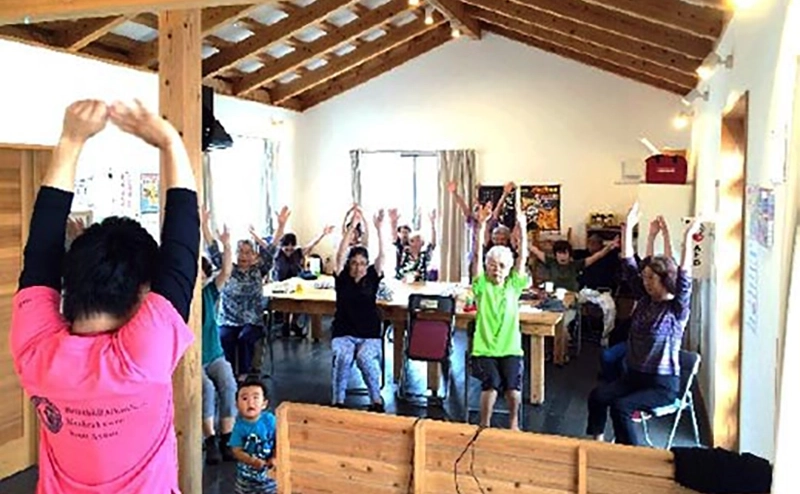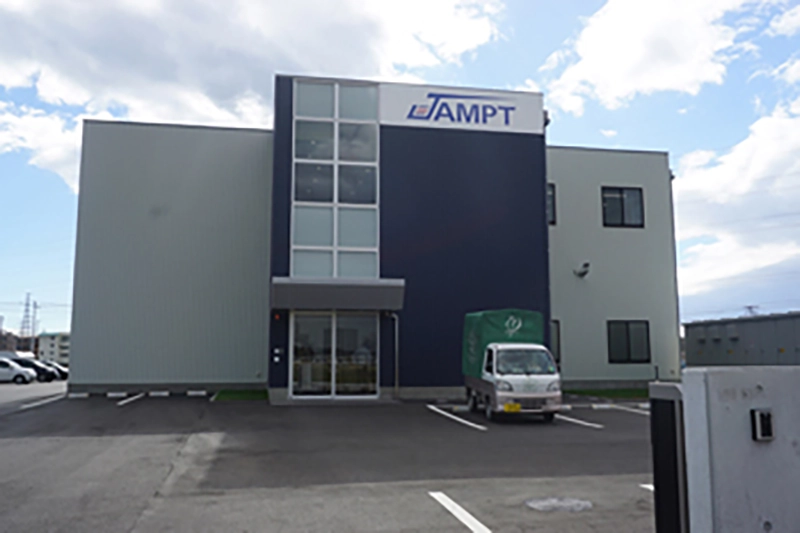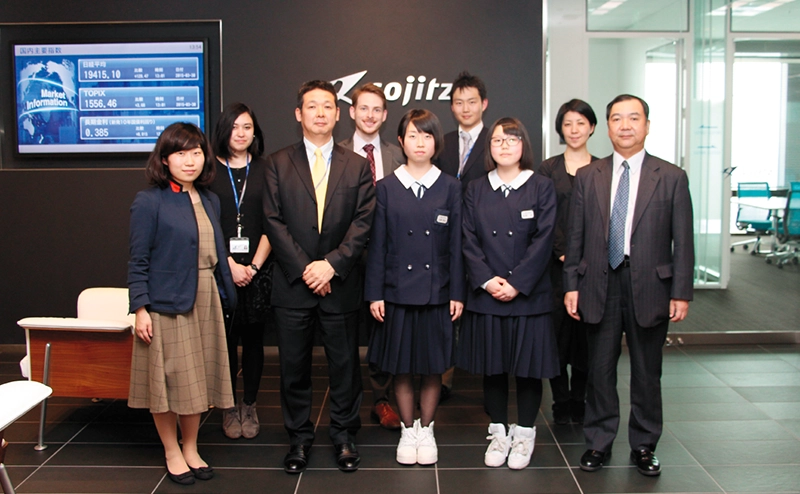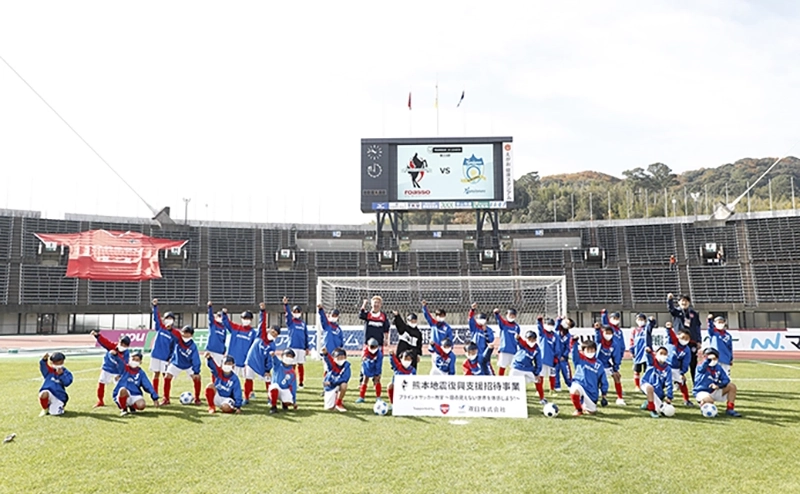Support for Reconstruction after the Kumamoto Earthquake and the East Japan Earthquake
The Sojitz Group promotes Group employees' participation in grassroots social contribution activities with the aim of deepening involvement in local communities.
Support for Reconstruction after the Kumamoto Earthquake
Sojitz contributed a total JPY 10 million in aid to victims of the April 2016 Kumamoto Earthquake directly following the disaster, including 2,400 liters of potable water.
In July 2016, Sojitz Group company Sojitz New Urban Development Corporation began selling bottled mineral water as another way to aid recovery in regions affected by the earthquake. The mineral water comes from two sources in Kumamoto Prefecture—Aso no Seisui from Kamimashiki and Kikuchi no Meisui from Kikuchi—while the bottle design features the prefecture’s popular mascot character Kumamon. By donating some of the proceeds from the water sales, Sojitz New Urban Development continues to use Kumamoto’s pure mineral water to support the prefecture’s recovery.
Even now, many victims of the earthquake live in temporary housing. Sojitz has been providing aid to the temporary communities in Kamimashiki since 2017.
Our continued support has created, maintained, and empowered these communities, not only by donating to local administrative groups, but though events such as trips for children to watch home games of the local J-League Team, Roasso Kumamoto; aquarium field trips for kids; and exercise classes for senior citizens.
Sojitz is also an official sponsor of Roasso Kumamoto. We have partnered with the team on their initiatives to help revive the affected areas and local community through sports, with Sojitz helping to establish “Roasso Kumamoto Junior Youth Aso” in April 2019.

-

Roasso Kumamoto Junior Youth Aso -

Exercise classes for senior citizens
Blind Soccer Workshop for Elementary Schools in the Disaster-stricken Region
In December 2020, Sojitz hosted an event titled “Blind Soccer Workshop: Experience the Unseen World” for children in cooperation with the Japan Blind Football Association (JBFA), for which Sojitz serves as an official partner. The workshop was held for 35 elementary school-aged members of FC Bigwave, a junior soccer team located in Mashiki, Kumamoto.
Support for Reconstruction after the East Japan Earthquake
Recovery efforts in the areas affected by the Great East Japan Earthquake and Tsunami continue even now.
Since the earthquake, the Sojitz Group has worked to support reconstruction in accordance with the Sojitz Group Statement. We recognize that in addition to the six Key Sustainability Issues (Materiality), we are also faced with the important task of providing support for the region’s reconstruction. Under our slogan of “working toward a brighter future for the people and local community,” we will continue to leverage our resources throughout Sojitz Group to support reconstruction in the Tohoku region.
Supporting Reconstruction through Our Business Activities
SOFCO Seafoods Inc.’s Otsuchi plant in Iwate Prefecture suffered large-scale damages in the disaster and was forced to suspend its manufacturing operations. With the support of its affiliates, SOFCO built a new plant in Kamaishi and resumed operations from March 2012. In addition to revitalizing the regional community, rebuilding the SOFCO plant has contributed to reconstruction and job creation on the coast, where the fishing industry is the main industry. SOFCO is working to rebuild its business, which is centered around its main product of salmon flakes.

In 2017, Sojitz announced its foray into metal product manufacturing using 3-D printer technology with its establishment of JAMPT Corporation. In fall 2018, JAMPT commenced operations at its new plant located in Tagajo City, Miyagi Prefecture, in an area recovering from the Great East Japan Earthquake. By collaborating with the local government and research institutions, JAMPT aims to become the leading company in the metal laminating industry and simultaneously contribute to the economic revitalization of disaster-hit areas.

Sojitz Reconstruction and Education Fund
Sojitz has set up a fund to assist university students who are experiencing financial difficulties in the wake of the disaster. For a five-year period starting in FY2011 right after the disaster, the fund granted scholarships to students (from a total fund amount of ¥500 million) for up to four years.
We had planned to temporarily stop accepting applications after FY2015, but considering how many students in the affected areas are still in need of assistance, we decided to continue to accept scholarship applications for an additional three years till FY2018 (from a total fund amount of ¥90 million), so that their education may contribute to faster recovery for the region and revitalization of these areas in the future. We continued to provide funds to students who received scholarships in 2018 up through their graduation in March 2022.
Number of Scholarship Recipients
| Group (Fiscal year) |
1st group | 2nd group | 3rd group | 4th group | 5th group | 6th group | 7th group | 8th group |
|---|---|---|---|---|---|---|---|---|
| Number of scholarship recipients | 52 | 37 | 38 | 35 | 39 | 9 | 12 | 11 |
Students who were granted a scholarship have said that thanks to the scholarship, they had been able to continue to attend university despite financial difficulties. Some also expressed their desire to work for the government after graduating and to be involved in supporting reconstruction of areas affected by the Great East Japan Earthquake and tsunami.
Educational Support/ Support for ‘The Collaborative School’
‘The Collaborative School’ is a project that provides support for after-school education. It is organized by Katariba*, a non-profit organization, and it provides after school educational guidance and the much-needed psychological care to children who have no place to study after losing their homes in the disaster.
We see new problems with households resulting from the stress of still living in temporary housing. (For example, increased truancy among children and increased stress for mothers raising children in these environments.) For this reason, Sojitz provided support for “The Collaborative School, Otsuchi Campus,” to give students a supportive place where they can receive afterschool tutoring.
-

Opening ceremony for the school's Otsuchi campus (Novermber 2013) -

Middle school students visiting Sojitz Tokyo HQ (March 2015) -

High school students visiting Sojitz Tokyo HQ (March 2016)
Event bringing together Sojitz employees and middle school and high school students of the Otsuchi Ringakusha Collabo School
Through the support of NPO Katariba, middle school students, high school students, and Sojitz employees were brought together for a 2-day event held on August 5th and 6th at the Otsuchi Ringakusha Collabo School.
<Purpose>
- Create an opportunity for middle and high school students to plan their future and expand their perspective.
- Provide a chance for Sojitz employees to deepen understanding of and think about the company’s outreach activities.
-

-
On the first day, 58 middle school students enjoyed a game of splitting the watermelon, followed by putting together a handmade Sojitz puzzle with the theme of the production of processed marine products (salmon flakes). SOFCO Seafoods, Inc., the producer of these salmon flakes, resumed operations after being destroyed by the Great East Japan Earthquake and Tsunami. Sojitz employees interacted with the middle school students through an extracurricular class on the role of a shosha and through individual presentations given by seven young employees.
-

-
On the following day, five high school students gave a tour focused on the charm of the town and conditions of the local community, including the “former Otsuchi factory,” the park with a panoramic view of the town, and the “wind telephone.” The students also shared their thoughts on living in their beloved town.
Through this memorable program, Sojitz employees were able to see the students persevering to overcome the hardship of the disaster and pursuing their dreams. It was also an opportunity for employees to see Sojitz through a different lens.
Volunteer Support System and Volunteer Tours for Supporting the Reconstruction of Tohoku
In its efforts to encourage reconstruction support activities and volunteer work among its employees, Sojitz has implemented a volunteer leave system and offers compensation for costs borne to participate in volunteer work. Countless employees have visited the Tohoku region to volunteer.
Since October 2011, Sojitz has shared information about volunteering opportunities in Iwate Prefecture and Miyagi Prefecture with Sojitz Group executives and employees. Main volunteering activities include support for events aimed at revitalizing local communities, sapling planting, and work to maintain coastal tidewater control forests.

-

Sojitz Group employees volunteering on a farm, helping to meet the needs of the local community. (Iwate Prefecture, FY2013) -

Sojitz Group employees remove debris (Iwate Prefecture, FY2011)
Tohoku Reconstruction Fair

The Tohoku Reconstruction Fair is a regular event held in the Iino Building where Sojitz Tokyo Head Office is located. Products and handicrafts made by disaster victims from Iwate, Miyagi, and Fukushima are available for purchase at the fair. The event is always well-received, attracting many visitors and with some items selling out completely.
Past fairs were held in July 2013, November 2013, February 2014, May 2014, August 2014, November 2014, March 2015, September 2015, March 2016, September 2016, March 2017, and March 2018.
Held in cooperation with: Non-profit organization Tono Magokoro Net and SOFCO Seafoods Inc.
Vehicle Donation to Support Recovery Efforts
A total of 14 vehicles have been donated by Sojitz Corporation to Otsuchi-cho Town in Iwate Prefecture and Tono Magokoro Net to support recovery efforts in areas afflicted by the earthquake and tsunami.
Details of the Vehicles
| Vehicle Name | Main Use | Donatee (# of vehicles) | Delivery |
|---|---|---|---|
| Microvan: Suzuki Alto Van VP (4WD) |
Transport public health nurses and nutritionists to visit disaster victims in evacuation centers and temporary housing. | Otsuchi-cho Town (5) Tono Magokoro Net (5) |
August 2011 |
| Compact Van: Toyota Hi-Ace Wagon GL (4WD) |
Transport NPO staff and volunteers between Tono City (Iwate Prefecture) and work sites in the coastal area. | Tono Magokoro Net (2) | October 2011 |
| Mitsubishi Minicab: MiEV electric vehicle |
Use for delivery of Magokoro Bento boxed lunches and other services in the town of Otsuchi. | Tono Magokoro Net (2) | August 2012 |
-

-
- Tono Magokoro Net (TMN) is a non-profit organization that conducts support programs in Iwate Prefecture through which about 100,000 volunteers have come to help.
Monetary Donations
The Sojitz Group donated ¥100 million to the region affected by the Great East Japan Earthquake in March 2011. Moreover, directors and employees of the Sojitz Group inside and outside Japan have contributed ¥16 million through fund-raising, collected from approximately 5,100 people. These monetary donations were given to the Red Cross, non-profit organizations working in the disaster area, and other organizations.
Initiatives and Fundraising Activities to Support Reconstruction Efforts
In the event of a disaster in Japan or overseas, Sojitz Group supports relief efforts for disaster victims and the reconstruction of affected areas by providing financial contributions and support. Sojitz Group is also involved in fundraising activities and support for countermeasures to fight the COVID-19 pandemic.
Main Disaster Relief Activities in Recent Years
| Disaster (Time of occurrence) | Donations (*) |
|---|---|
| Relief Aid for Damage Caused by Typhoon Yagi in Vietnam (September 2024) | Donated $10,000 |
| Relief Aid for Earthquake Damage in Taiwan (April 2024) | Donated ¥5 million, plus NT$ 50 thousand from Sojitz Taiwan Corporation |
| Relief Aid for Earthquake Damage in the Noto Peninsula (January 2024) | Donated ¥10 million |
| Relief Aid for Earthquake Damage in Morocco (September 2023) | Donated ¥5 million |
| Relief Aid for Earthquake Damage in Turkey (March 2023) | Donated ¥10 million |
| Relief Aid for Flood Damage in Pakistan (November 2022) | Donated ¥3 million |
| In-house employee fundraising for emergency COVID-19 relief conducted at workplace vaccination sites and matching contribution donated by Sojitz (2021) | Sojitz Group employees donated ¥990,957 (with Sojitz matching the donation amount) |
| Relief Aid for Damage Caused by the July 2020 Kyushu Floods (July 2020) | Donated ¥5 million |
| Relief Aid for Damage Caused by Typhoon Hagibis (October 2019) | Donated ¥5 million |
| Relief Aid for Sulawesi Earthquake and Tsunami (October 2018) | Donated IDR 500 million (about ¥3.75 million) together with Sojitz Indonesia |
| Relief Aid for Earthquake Damage in Eastern Iburi, Hokkaido (September 2018) | Donated ¥3 million |
| Relief Aid for Heavy Rain Damage in Western Japan (July 2018) | Donated ¥10 million |
| Relief Aid for Earthquake Damage in Kumamoto (April 2016) | Donated cash, drinking water and other supplies totaling ¥10 million on behalf of the Group |
| Relief Aid for Areas Damaged by Tropical Storm Etau (September 2015) | Donated ¥1 million |
| Assistance for Earthquake in Nepal (April 2015) | Donated ¥1 million |
| Assistance for Earthquake Stricken Areas in Yunnan Province, China (August 2014) | Donated ¥1 million |
| Relief Aid for Typhoon Damage (Typhoon Haiyan) in the Philippines (November 2013) | Donated ¥10 million on behalf of the Sojitz Group |
| Relief Aid for New York City (for Victims of Hurricane Sandy that Hit the United States) (November 2012) | Donated $50,000 (equivalent to ¥4.2 million) on behalf of the Group |
| Thailand Flood Damage (August 2011) | Donated cash and relief supplies totaling ¥10 million together with Sojitz Asia and Sojitz (Thailand) |
| Great East Japan Earthquake (March 2011) | Donated ¥100 million |
| Christchurch earthquake (February 2011) | Donated ¥1 million together with Sojitz New Zealand |
| Brazil Flood Damage (January 2011) | Donated ¥3 million together with Sojitz do Brasil |
| Queensland, Australia Flood Damage (January 2011) | Donated A$100 thousand (about ¥8.3 million) together with Sojitz Australia |
| China Landslides (August 2010) | Donated ¥1 million together with Sojitz (China) |
| Pakistan Flood Damage (July-August 2010) | Donated ¥1 million |
| Earthquake in Qinghai Province, China (April 2010) | Donated ¥1 million, plus ¥200 thousand from employees of Sojitz (China) |
- Cash donations are given to the Red Cross in each country and to NGOs working in the disaster areas.


